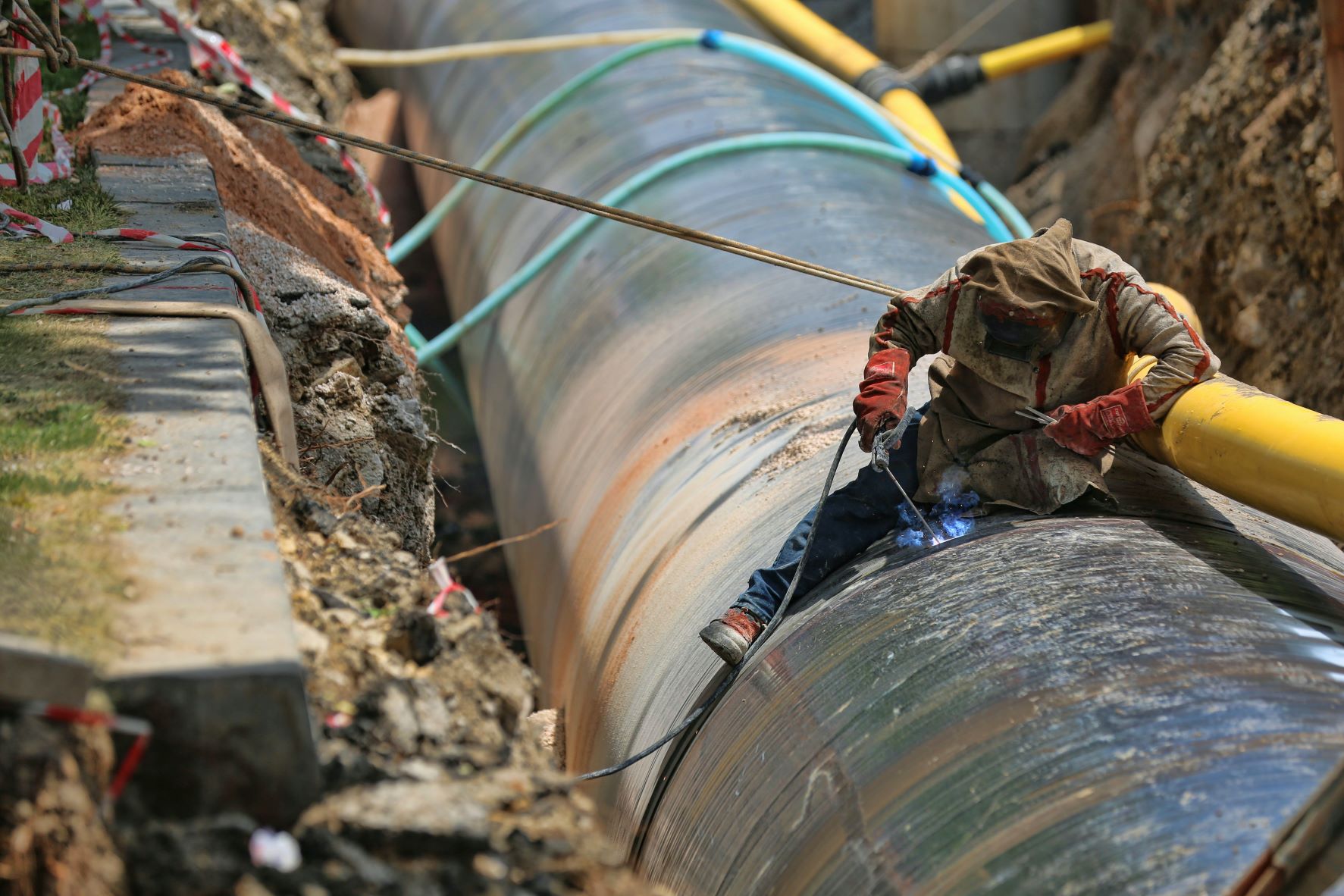Russian President Vladimir Putin’s decision to invade Ukraine throws Europe into a new war on its continent. This decision will have significant repercussions both in the immediate and longer term. Sanctions on gas, worth around 3% of Russian GDP and 7% of Kremlin’s budget, and preparations for a cut off in gas imports from Russia should be part of an effective response to both hit the drivers of this conflict and building a new resilience.
One of the most problematic factors in the relationship between Europe and Russia is Europe’s – and particularly Italy’s – heavy dependence on Russian gas imports and the associated outflow of capital. In the decade between 2010 and 2019, Italy’s average annual expenditure on gas imports amounted to €17 billion, for a total of €167 billion over ten years. Using prices of the Italian day-ahead gas market, the annual share of Russian gas imports can be estimated at over €6 billion in the pre-Covid years, while the value exceeds now €29 billion at current prices. To understand the real weight and trends of Italy’s Russian gas import volumes, it is useful to read them in the context of the evolution of gas demand and supply over the last 15-30 years.
After the peak of national gas consumption in 2005 (up 80% since 1990), consumption has reversed the trend, falling by 14% between 2005 and 2019. This is a direct consequence of the first set of European energy and climate targets by 2020, which have driven new energy efficiency policies and the penetration of renewables – although this has been halted since 2014 -, the progressive reduction in industrial output and the economic crisis of 2008-2009. This trend is expected to accelerate as a result of the tighter climate commitments by 2030 and 2050, with a drop in gas demand expected in Europe of more than 20% in 2030 according the International Energy Agency. Gas imports have followed a similar trend, peaking in 2006 and falling by more than 8% by 2019. However, within this downward trend, Russian gas imports increased by 40% through a jump between 2012 and 2013 that offset the sharp decline in Algerian imports. Since then, their import levels have remained constant, ending 2019 at around 33 bcm.
Russia’s act of war against Ukraine has finally brought about a consensus on the need to reduce dependence on Russian gas. But it also casts light on the broader fragility of Europe’s dependency on gas and oil imports, which makes the continent highly expose to price volatility, supply shocks and security risks while fueling anti-democratic regimes.
The choice of weaning itself off gas must also be taken in the context of the other major challenge of our time: climate change. The new IPCC report on climate impact, adaptation and vulnerability shows how exceeding the 1.5 degree threshold would cause an irreversible loss of entire ecosystems, exposing people and nature to risks to which they will not be able to adapt. If emissions keep rising at projected rate, the resulting temperature rise will threaten food production, water supplies, human health, coastal settlements, national economies and the survival of much of the natural world, increasing the risk of extinction for unique and threatened species. This is a permanent crisis scenario.
Phasing out Russian gas dependency must therefore go hand in hand with the broader phasing out of gas. This means accelerating the trend already underway since 2005, with the goal of building a new geopolitical, economic and climate resilience that does not fuel a succession of crises but protects us from them. In Italy, gas has been the transition fuel from 1990 to early 2000s. Today, Italy’s key challenge is to transition from gas to a clean energy system.
In recent years we had the opportunity to strengthen this type of resilience by accelerating climate policies and reducing the dependence on gas. Instead, the Government’s interventions have focused on reducing gas and electricity costs on end consumers, without introducing targeted support measures for the most vulnerable. More than €10 billion in public resources have been spent and none of the measures actually addresses the gas crisis. On the contrary, the consumption subsidy distances the consumer even further from energy saving actions, which are the indispensable and a priority measure to reduce dependence on Russian gas as well as to face the climate challenge. Current management, including President Draghi’s urgent briefing to the Chamber of Deputies on 25 February, continues to ignore the great potential for savings in both the immediate and the medium to long term. By prioritising savings and citizen responsibility, structural energy efficiency, the immediate unblocking of renewables and the use of existing gas infrastructure, Italy would be able to respond to the Russian supply cut without new gas infrastructure and restarting coal plants or new domestic production. Public opinion is more ready to move away from gas than the ruling class. A new poll to be published soon, conducted by YouGov for More in Common and ECCO, shows that the majority of Italians, across the political spectrum, are ready to either gradually or immediately stop using gas.
What is surprising from the Government’s response is the lack of any reference to the importance of savings as a collective and responsible response and as a peaceful means of reacting to wartime aggression and freeing ourselves from the gas blackmail. In this analysis, we have developed energy-saving assumptions to show how immediate, collective action supported by a public communication campaign and combined with a faster development of renewables, can replace the equivalent of 50% of Russian gas imports within a year. Collective and determined action should aim to reduce gas consumption by around 15 bcm per year, equivalent to a saving of €14.5 billion per year on Russian imports at current costs. Leveraging in parallel the full exploitation of existing gas infrastructure, Italy would be able to manage the Russian gas outage over the next year. The total storage capacity in Italy amounts to almost 18 bcm, equivalent alone to half of the average Russian imports over the last 5 years. The “non-Russian” pipelines of Passo Gries, Mazara del Vallo and Gela are largely underused (16%, 24% and 45% respectively in the pre-Covid thermal year 2019-2020) and amount to an aggregate annual transport capacity of more than 100 bcm plus another 10 bcm from the TAP pipeline. The utilisation rate of Italy’s three LNG terminals (Rovigo, Livorno and Panigaglia) still has a margin of increase by about 20% compared to 2020. In aggregate, the available annual capacity of Italy’s LNG terminal amounts to about 20 bcm.
Before calling for a dash for new gas and related infrastructure, top priority should be given to all alternatives to gas and the exploitation of existing infrastructure. Europe’s reliance on new infrastructure, such as Nord Stream 2, has been completely overestimated and counterproductive. And we cannot create new dependency and risks with other countries and regimes in the Mediterranean without an analysis of real needs and alternatives that meet both energy and climate security. Increasing domestic gas is neither an impactful nor a sustainable solution. The increase of less than 2 billion cubic metres per year envisaged in the Government’s plan corresponds to 6% of Russian gas imports, has much higher extraction costs and requires a huge tax intervention paid by all to lower prices. “Cheaper domestic gas” does not exist and the reopening is in clear contradiction with Italy’s international commitments made at the G20 and COP26 in 2021.
A call for responsible energy consumption is needed at all levels and for all citizens, accompanied by an acceleration of renewables. At the same time, priority must be given to deploying the enabling electricity infrastructure (electricity grids, batteries, pumped storage and demand-side flexibility). With this in mind, we have quantified assumptions for the immediate and available savings, energy efficiency and renewables measures which needs immediate priority. The table below summarises the savings option over a one-year period. Savings measures from citizens and rules for reducing heat and electricity consumption have an immediate effect while the adoption of new technologies takes 6 to 12 months. The equivalent savings in Russian gas imports would be over 50% and amounts to €14.5 billion per year at current costs.
In detail:
- Savings on heating. In civil use, a reduction of one degree of heating saves about 7% of gas. This is without taking into account the waste, visible everywhere, of heating in homes and public buildings. Savings can be made by regulating the heating season and by reducing heating temperatures. Working from home can also unlock savings in public and private offices. Reducing temperatures by 2°C, as a measure to cope with an emergency situation, combined with waste reduction and working from home solutions, amount to a potential saving of 15% compared to current consumption, equivalent to about 4 This is more than double the potential promised by new national drilling.
- Replacing gas boilers with heat pumps increases the efficiency of the heating system. For example, replacing gas boilers with heat pumps in 10% of homes would save around 1 bcm. It is therefore necessary to review the “110% Superbonus taxbreak policy” and exclude access to it for new gas boilers. Instead, incentives for replacing gas boilers with efficient heat pumps is urgently needed to reach the savings target.
- Awareness campaign for savings in the electricity sector. ENEA – the Italian Energy Research Center – estimates the potential for reducing final consumption by 10% to a detailed set of actions. This would be equivalent to an impact on gas consumption of 3 bcm. This campaign would have an immediate impact and can affect both behaviour, public consumption and the replacement of final equipment. Instead of using resources from the carbon credit market auctions (ETS) to reduce system charges, it would be much more useful to activate contingent support instruments for the replacement of obsolete equipment.
- The development of grid-based renewables in the electricity sector, as pointed out by the Italian electricity association Elettricità Futura, could lead to 20 GW of new renewables per year over the next three years. This would lead to a reduction in gas consumption of around 5 bcm per year, more than double the expected increase in new national gas production. This is why it is essential to immediately unblock authorisations, which have been blocked for years by administrative procedures.
- Photovoltaic installations on buildings must go hand in hand with the development of renewables on the grid. The 2.2 GW target set by the National Research Programme for municipalities with fewer than 5,000 inhabitants should be extended to 5 GW, with no limit on the size of municipalities. This measure would allow annual savings of 1.2 bcm.
- Renewables in the industrial sector. A further 5 GW should be promoted in the industrial sector through the removal of authorisation barriers and fiscal policies, such as IMU discounts on warehouses used for photovoltaic production. The support provided by the recent Decrees should be conditional or introduce bonuses for industries that invest in renewables. The expected gas savings in this case are estimated at 1.2 bcm.
- Savings in the industrial sector. Energy efficiency in the industrial sector can be increased through the resources available in the first mission of the NRRP, making energy efficiency a priority. It is suggested that this mission (in which the word energy does not even appear at the moment) directs funds as a priority to activities promoting energy efficiency in industry. A 10% saving in the industrial sector would be worth 1 bcm.
- Reducing gas consumption in transport. Lastly, a saving of 0.5 bcm of gas in the transport sector could be achieved by removing the tax rebates currently granted for gas consumption for mobility, the benefits of which in energy and environmental terms are small.
In general, the promotion of a savings culture must take precedence over everything else. Artificially calming down price increases for everyone, instead of adopting a logic of selective protection for the most vulnerable groups, has led to unchanged behaviour. An information campaign is needed on the value of energy savings. In the 1970s, Italy reacted to the energy crisis by activating savings potentials and turning to energy efficiency. We still benefit today from the choices of those years. In parallel and policy-wise, it would be appropriate to introduce a tariff system that guarantees sustainable access to an initial bracket of consumption, and that progressively introduces higher charges for gas once a “social threshold of consumption” has been exceeded.
Photo by SELİM ARDA ERYILMAZ on Unsplash






